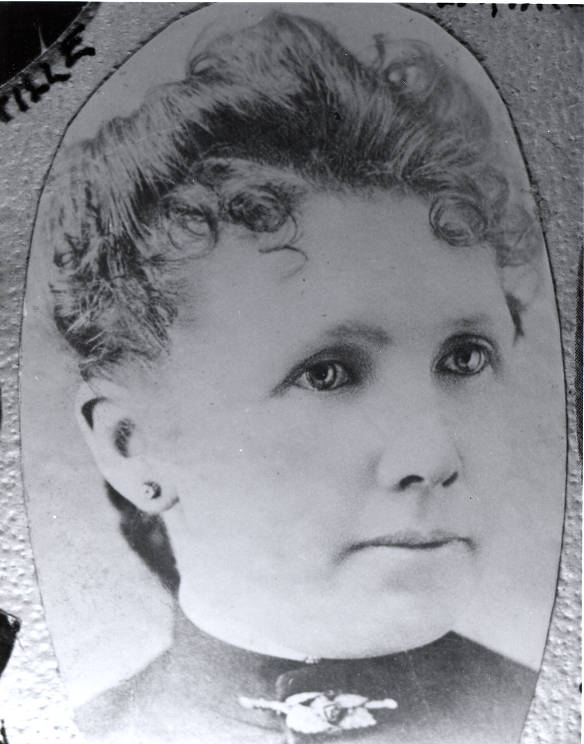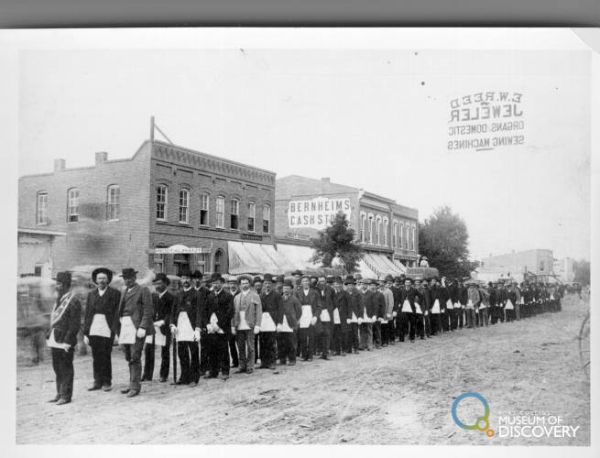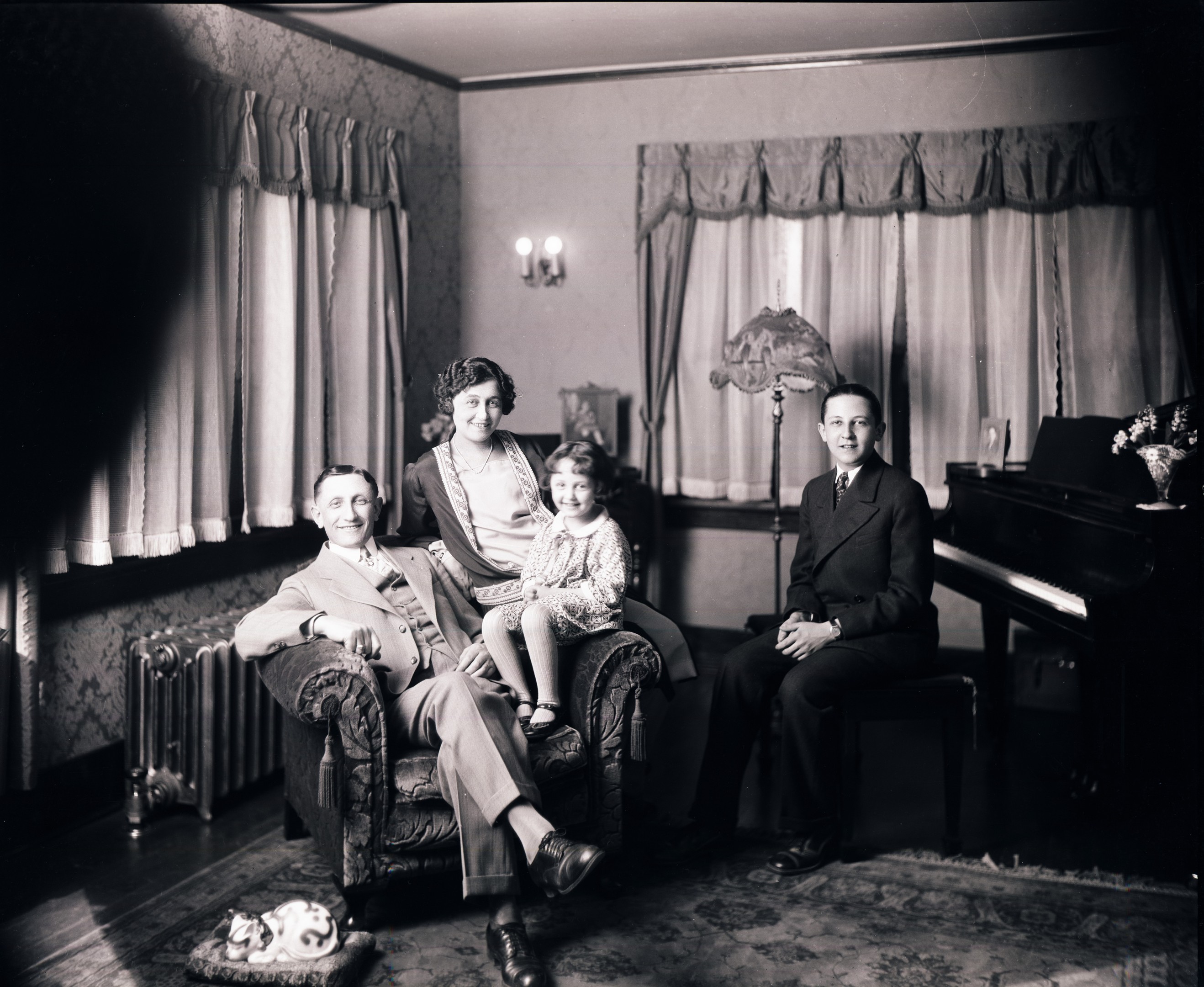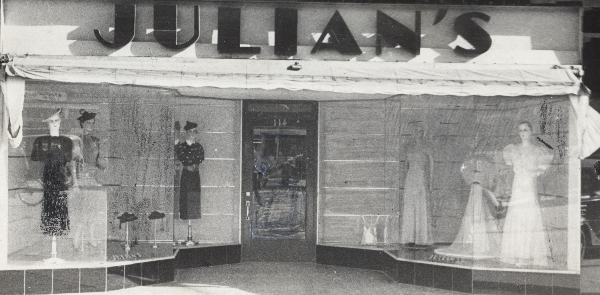Jewish Americans in Fort Collins#
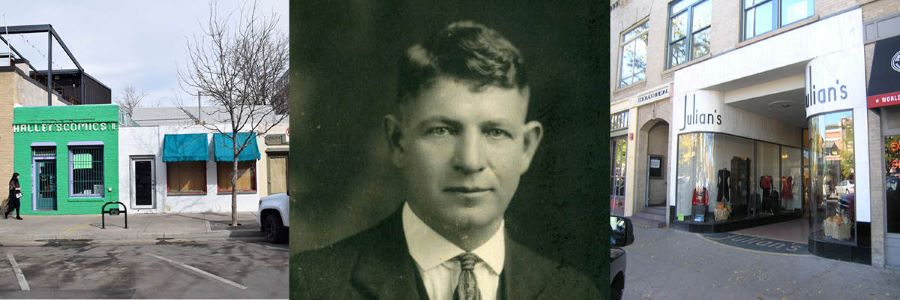
Images (Left to Right): Left: 322-26 Walnut St., the Reingold Shop; Center: Joseph Alpert, c1926 (Fort Collins Museum of Discovery); Right: Julian's, 133-137 S. College Ave.
Special thanks: The City of Fort Collins Historic Preservation Services division would like to especially thank our intern and CSU graduate, Kristy Ornelas, and community members including Karen Schwartz, Judy Petersen, and Rabbi Yarachmiel Gorelik for their time and input to assemble this page.
As of 2023, Colorado is home to over 98,400 Jewish Americans, some of whom have made the growing city of Fort Collins their place of gathering, their place of established business, and their home. The Jewish identity is broad but is generally defined as a worldwide group that constitutes, through descent, kinship or conversion, a continuation of the ancient Jewish people, who were themselves descendants of the Hebrews of the Bible. Since the mid-nineteenth century, Jewish Americans and new Jewish immigrants from diaspora communities in Germany, eastern Europe, and other countries began to establish themselves in Denver and early settlements across Colorado as mining and ranching grew the territory into a state. By the mid-1900s, Fort Collins boasted several Jewish-owned businesses, Jewish community groups, and a Jewish fraternity at the Colorado Agricultural College, now Colorado State University.
The Jewish community in Fort Collins continued to grow through the twentieth century. People gathered in private homes to hold religious ceremonies and on campus to celebrate the Jewish high holidays. While the Jewish community was small, its members created community with each other while also contributing to the wider social, economic, and cultural environment of the city. In the late 1980s, Congregation Har Shalom constructed Fort Collins’ first Jewish synagogue to serve as an official gathering space. Sixteen years later, Colorado State University established a Hillel chapter to serve students on campus and to connect them to their Jewish heritage in whatever way students desired.
Old newspapers and archives provide a partial glimpse into the lives of Jewish people in Fort Collins since the late-nineteenth century. The Jewish residents of Fort Collins varied in their observance of Jewish traditions, laws, and with which denomination of Judaism they identified. Newspaper archives also document antisemitism in Fort Collins. Although that documentation is sporadic, both the larger historic context at this time and specific evidence from Fort Collins sources such as newspapers reveals that Jewish people experienced religious and ethnic discrimination here, in stereotyping, and likely housing and employment as well. For example, the Ku Klux Klan, America’s most notorious white supremacist and antisemitic organization, had sizeable membership in northern Colorado in the 1920s and held regular events in Fort Collins in that decade.
This timeline is just the beginning of capturing Jewish history in our community, but it provides a starting point and helps tell a more complete story of Fort Collins’ past. If you have additional information that would add to this history, or would like to share your own story, please contact us at preservation@fcgov.com.
Discover Jewish Historic Places in Fort Collins
As a companion to this history page, we have developed a virtual tour of Jewish historic sites in Fort Collins. You can explore these places exclusively online, or visit these places in person on foot or by bike and use the virtual tour as a companion as you explore the sites. All four primary locations are located in the downtown Fort Collins area.
Mid- to Late-1800s:
1850-1880: The Euro-American discovery of Colorado gold in the 1850s unleashed a wave of settlement to present-day Denver and other towns. New residents included many Jewish people of German descent. As more people arrived and sought work opportunities, Jewish people began joining communities in areas such as Cripple Creek, Colorado Springs, Fort Collins, and more.
1874: The Hebrew Burial and Prayer Society, Denver’s first Jewish organization established in 1866, formed Temple Emanuel, and built the first synagogue in the Rocky Mountain region in 1875 at the corner of 19th and Curtis Streets.
1878/1879: William S. Bernheim moved from Philadelphia to Fort Collins and through partnerships established a dry goods business on the ground floor of the Odd Fellows Hall building on Linden Street. He soon married a young woman from a Christian family, Harriet Smith, also known as Hattie, and they had five children together. Bernheim is one of the earliest documented Jewish settlers in Fort Collins.
1881: Bernheim built a dry goods store at 214 Linden Street, which is listed on the National Register as The Bernheim Block, a contributing building to the Old Town Historic District.
1880s: Circumstances in Eastern Europe, including the former Russian and Austro-Hungarian Empires drove many Jewish people to flee economic hardship, religious discrimination, and violence. Over two million Eastern European Jews immigrated to the United States, known in Yiddish to some as the ‘Goldineh Medinah’ or the ‘Golden Land.’
1881: William Bernheim and his family were well-connected socially and through business ties in the community, and William was a member of the Masonic Lodge No. 19. Despite their comparatively influential social status, evidence shows they endured discrimination from some Fort Collins residents. On October 6, 1881, the Fort Collins Courier defended William S. Bernheim, saying Bernheim was “one of Fort Collins’ most enterprising and public spirited business men” after the Express referred to Bernheim as an “unmistakable Jew.”
Bernheim store in background (Masons event), c.1886, Courtesy of the Fort Collins Museum of Discovery.
1883: Louis Bernheim, brother of William S. Bernheim, moved to Fort Collins and opened a clothing store for men and boys on Linden Street. Bernheim had a daily puzzle that he encouraged people to solve at his store. He was treasurer of the Hook & Ladder Company, part of the local volunteer firefighting service, and remained in town until about 1900.
1886: Wad El Ward, also known as Professor Rosedale, lectured at the Fort Collins Opera House about the customs of Jewish people, sponsored by the Ladies Aid and Missionary Society of the Presbyterian church. Wad El Ward was a rabbi born in Jerusalem who converted to Christianity. He traveled around Colorado lecturing about the cultural and customs of the Middle East, including Jewish and Islamic customs. He gave a few of these lectures in Fort Collins.
1890: William Bernheim closed his shop and sold his inventory at auction due to an east coast recession that affected the importation of his store goods.
1895: William Bernheim died in Chicago and was buried in Grandview Cemetery next to his wife, Harriet, who died in 1893.
Early 20th Century Jewish Residents of Fort Collins
1905: Samuel L. Meyer, an immigrant from Poland, moved to Fort Collins from Rocky Ford in 1877. Meyer opened a dry goods store on 222 Linden Street called the Meyer Store at which he sold clothing for all ages and other goods.
1908: Samuel L. Meyer expanded his store and moved it across the street from his 222 Linden Street location. Meyer also married Ida Solomon the same year.
1911: Samuel L. Meyer moved his store to its final location at 136 S. College Ave.
1913: The Fort Collins Courier reported on a happy gathering at the home of Edward and Sarah Brunstein at 406 Peterson, where a bris ceremony was performed on their grandson Maurice, the child of their daughter Pearl Brunstein Tittman and her husband Oscar Tittman. In addition to Rabbi Baskovitz of Denver, several prominent members of the Fort Collins Jewish community attended including Mr. and Mrs. Abe Solomon.
1913: Local Jewish women organized Miriam, the Jewish Ladies’ Society in Fort Collins. The women elected Augusta Solomon, wife of Abe Solomon, as president of the society. Interested women could apply for membership at Mr. And Mrs. Solomon’s business, the New York Art Store at 229 W Oak. The Solomons New York Art Store had several different locations around town during its years of operation.
1915 or 1916: Charles Reingold, described as an observant Jew, and Minnie Gerber, his wife, arrived in Fort Collins from Chicago where they first settled after immigrating from Russia.
1916: A relief association started in Denver named Samuel L. Meyer honorary vice president in January of 1916. The association aimed to collect funds to help the “persecuted and distressed Jews” in Europe during World War I. Meyer appealed to the residents of Fort Collins to help the cause.
1917: Joseph Alpert, a Jewish immigrant from Odessa, Ukraine (then Russia), moved his shoe repair and sales business into a one-story building that used to sit at 140-142 S. College Avenue, which he would later purchase in 1924. Some of Alpert’s family were killed in 1885 during one of several Tsarist pogroms against Jewish people in Odessa. The family relocated to the United States sometime in the 1880s or 1890s.
1919: Charles Reingold opened the Reingold House and Junk Store on 322-326 Walnut Street. Reingold had previously operated a grocery and second-hand store on Linden Street.
1919: Abe Solomon and Augusta Solomon’s New York Art Store was listed in the city directory at 509 E Olive.
1921: In the early 1920s, Jewish residents of Fort Collins established Congregation B’nai Zion. They held services in public halls and purchased a Torah. Prior to this, it appears that local Jewish residents held services in private homes. Congregation B’nai Zion dissolved by the mid-1920s. Some sources suggest that Jewish organizers felt compelled to establish the congregation in reaction to the presence of the Ku Klux Klan in the city, the terrorist organization that gained rapid momentum in Colorado in the 1920s with anti-immigrant, anti-Black, anti-Hispanic, anti-Catholic, and antisemitic activities. The Ku Klux Klan opposed any deviation from what they labeled as traditional American values and attempted to intimidate their targets and recruit new members through many white supremacist performances and acts of violence around the nation including in Larimer County. It is likely that the Ku Klux Klan targeted Jewish residents of Fort Collins or at least aimed to intimidate Jewish residents.
1921: After Congregation B’nai Zion dissolved, cantor Charles Reingold became the caretaker of the Torah in Fort Collins until the 1950s, when he left it in the care of Congregation Beth Israel in Greeley before moving to Nebraska. Today, the “Pioneer Torah” is back in Fort Collins at Congregation Har Shalom.
Mid-20th Century
1924: On August 17, 1924 the local Ku Klux Klan chapter published an advertisement in the Fort Collins Express-Courier aimed to increase membership. The advertisement read:
“Are you 100% American and do you believe in the tenets of the Christian religion, white supremacy, protection of our pure womanhood...?” The advertisement continued to list several qualifiers that its ideal recruit would possess such as wanting to prevent "mob violence and lynchings" and wanting to limit "foreign immigration." Other qualifiers included wanting to keep law and order, and a desire for "upholding the constitution of these United States.”
These statements stood in stark contrast to the Klan’s actions, which included lynchings, mob violence, and actively subverting the 14th and 15th Amendments to the Constitution.
1924: On April 9, 1924 the local Ku Klux Klan chapter in Fort Collins held a gathering and burned a cross on the City Park campground.
Julian Siegel's first store at 114 S. College, prior to relocating to the Colorado Building. (Courtesy of Fort Collins Museum of Discovery).
1924: Joseph Alpert replaces the one-story building at 140-142 S. College he had previously purchased with a two-story building that remains today, continuing to run his shoe store there, as well as opening a real estate office.
1925: William Reingold, son of Charles Reingold, operated a Fort Collins Clothing Store selling clothing, furniture, and shoes at 326 Walnut.
1924: Polish Jewish immigrant Julian Siegel arrived in Fort Collins in 1924 and began working as a door-to-door salesman. He soon opened Julian’s, a women’s clothing store at 114 S. College Avenue.
1928: In May of 1928, Aggie students at Colorado Agricultural College, now Colorado State University, organized Zeta Nu fraternity, likely the first Jewish social fraternity on campus. Morris Solomon was named president, Morris Pepper was elected vice president, James Kraft as executive secretary, Ben Gvirtzman as recorder, and Morris Hoffman as honorary president because he helped organize the fraternity. More members would later join, including Joe Gvirtz and Ben Nelman. The Zeta Nu fraternity did not have a house or an established location for meetings or gatherings.
1936: After receiving an invitation to join the “The Christian Party” meant for “white, protestant gentiles only,” local resident Jimmy Higgins expressed his dislike of the invitation and proclaimed his support for Jewish people in an op-ed column in the Express-Courier.
1942-76: Julian Siegel moved his store, Julian’s, to the Colorado Building in the early 1940s where the business remained until he retired in 1976. Siegel had significant impact on the Fort Collins community, such as supporting several charitable causes and selling war bonds during World War II. Reverend Harold McMillian, of the Congregational Church, and Siegel visited local Fort Collins restaurant owners attempting to convince them to take down the “Whites Only” signs hung in their windows. Ed Siegel, son of Julian Siegel, still owns the north half of the Colorado Building, which bears the commercial signage and Modern storefront design from his father’s store.
1945: On April 9, 1945 Rabbi Martin Weitz of Denver, a veteran of the Second World War and a regional advocate for religious unity and anti-racism in the 1940s. presented at Colorado State University and later at the War Dads group in Fort Collins.
1945: The Circle Drive neighborhood is platted and includes a restrictive covenant against ownership by “any race other than the Caucasian race.” In 1948, the Slade Acres neighborhood followed suit. Restrictive covenants on the basis of race were deemed unconstitutional by the U.S. Supreme Court in the 1948 Shelley vs. Kraemer decision. Throughout American history, restrictive covenants were sometimes used to exclude Jewish Americans - the social construct of race has shifted over time and for Jewish Americans, it has depended on time and place whether they themselves identified as white/Caucasian, and whether non-Jewish European Americans considered them White as well.
1948: Samuel L. Meyer converted the second floor of his building at 130-136 S. College Avenue to office space for realtors, dentists, physicians, attorneys, engineers, and for a music studio.
1950s: Charles Reingold handed over the “Pioneer Torah” to Congregation Beth Israel in Greeley.
Mid- to Late-Twentieth Century
1954: The Rocky Mountain Collegian reported that students at Colorado State College of Agriculture and Mechanic Arts, now Colorado State University, were facing religious and racial discrimination. Zeta Beta Tau, a national Jewish fraternity, voted to drop all religious and racial clauses at summer conclaves to support religious inclusion.
1957: The Rocky Mountain Collegian reported that the Jewish Student Group would be holding a meeting in Eddy Hanna Lounge at Colorado State University. The meeting would include regular organization business and a talk from Rabbi Earl S. Stone from Temple Emanuel of Denver.
1958: Colorado State University held a Religious Emphasis week for students to reflect on their diverse faiths. One speaker invited was Rabbi Daniel Goldberger, the rabbi at Congregation Beth Joseph in Denver, to lecture on the Jewish faith.
1959: Along with other campus religious groups, the Jewish Student Organization held an open house for incoming students on September 18, 1959. Throughout the 1960s, the JSO met in churches such as St. Paul’s Episcopal Church. Reverend Malcom Boyd had this to say about hosting the city’s small Jewish community for Passover in 1961: “It is a religious obligation to overcome prejudice which generally seems to be an outgrowth of fear which breeds on ignorance. All religions share the benefits of freedom in our democratic pluralistic society.”
1960: On January 15, 1960, the Rocky Mountain Collegian reported that swastikas were found on Jewish Greek houses at the University of Colorado in Boulder. This news appeared to shock Colorado State University students, prompting them reflect on antisemitism on their own campus. Four days later, the January 19 Collegian’s editor’s column noted the Boulder vandalism and encouraged both discussion about antisemitism and deplored that such actions occurred on a college campus. The editorial board also syndicated a letter to the editor in Louisiana State University’s Daily Reveille submitted by a professor that reminded readers of the connection between the swastika and the genocide of the German Nazi party, stating this:
“The swastika is more than just a symbol of a political movement. It is a constant reminder of uncounted dead in concentration camps and ghettos, of savage men using a nation to further their warped ideas, of millions dead in a useless war, and of man’s capacity for evil.”
The level of attention afforded by the Collegian suggests antisemitism was observable at CSU and in Fort Collins at this time as well.
1961: Samuel L. Meyer passed away on June 18, 1961.
1964: Dr. Carl Levine and his wife, Gus Levine, moved to Fort Collins when Carl Levine joined the English Department faculty at Colorado State University. Dr. Levine had worked all over the world, in places such as Germany, Israel, and all over the United States. The Levine family dedicated their lives to helping students get access to mental health resources, providing assistance for migrant workers in Wisconsin, sending assistance to refugees, and honoring Raoul Wallenberg, a Swedish diplomat in Nazi-occupied Hungary who saved the lives of nearly 135,000 Hungarian Jews before disappearing in Soviet custody. Dr. Levine also wrote a play about Wallenberg that was performed in New York City and Fort Collins.
1966: Members of the Colorado State University Jewish Student organization sponsored and conducted services for the Jewish Holy Days of Rosh Hashanah (the Jewish New Year) and Yom Kipper (Day of Atonement) at the Danforth Chapel on campus.
1967: Fort Collins community members formed the Jewish Fellowship to “foster Jewish cultural and social values on campus and in the community.” They held a meeting at the home of Dr. And Mrs. J. Leo Cefkin on February 18, 1967.
1969: On September 19, 1969, Colorado State University students and faculty members, including Dr. Carl Levine, held services for Yom Kippur, the Jewish Day of Atonement, at the Congregational Unitarian Church.
1970: On April 13, 1970, Dr. Carl Levine and others celebrated Passover Seder at the University’s International Center at 633 South College Avenue.
1973: The Israeli Student Organization, ASCSU, and other student organizations jointly sponsored an Israel Festival in April, which included an appearance by Chava Albertstein, the prominent Israeli folk singer, and public folk dancing.
1973: The Yom Kippur (Arab-Israeli) War begins when Egypt and Syria attacked Israeli forces in the Sinai Peninsula and the Golan Heights. The conflict sparked discord among CSU students who were expressing their concerns about the conflict. The Rocky Mountain Collegian featured editorials from individuals and the student organizations representing different points of view about the war.
On October 9, three days after the start of the conflict, the Israeli Student Organization and members of the local Jewish community organized a peace vigil at Colorado State University’s Student Union to inform students about the ongoing conflict. When members of the Arab Student Organization arrived, a confrontation between students from each group ensued.
1975: Several local Jewish families founded a religious school known as the Fort Collins Jewish Community. The school began in members’ homes until growing to the point of needing a permanent structure, which would become Congregation Har Shalom.
1978: The Jewish Community sponsored a discussion led by Dr. Carl Levine on Holocaust Remembrance Day on April 30, 1978.
1981-82: Congregation Har Shalom constructed the first synagogue in Fort Collins at 725 W. Drake Road—the result of a family-led effort to establish a Jewish school beginning in 1975. Finished in 1982, the synagogue and school had eighty original member families and thirty-seven students. As a result, Congregation Beth Israel in Greeley returned the “Pioneer Torah,” formerly kept by the Reingolds, to Fort Collins.
1996: Hillel of Colorado purchased a house for the Colorado State University Hillel chapter. Since 2007, the Hillel Center has been located at 720 W. Laurel, near the university.
1997: The first Holocaust Awareness Week at Colorado State University was held. The event continues to this day, organized by Colorado State University's Students for Holocaust Awareness, Chabad Jewish Student Organization and Hillel: The Foundation for Jewish Campus Life.
2001: Temple Or Hadash, the first Reform Judaism congregation in Northern Colorado, was founded by three families, including Judi and Frank Deming, and Gerald and Elaine Weiss.
21st Century
2005: The City’s Downtown Development Authority denied a request from Rabbi Gorelik of the Chabad Jewish Center of Northern Colorado to place a menorah alongside the Christmas tree in the city’s public holiday display in Old Town Square. After he changed the request to anywhere on public property, the City again denied the request under a policy that prevented placement of “unattended signs or displays” on public property. The menorah was installed instead on private property at Coopersmith’s Pub. A 1989 U.S. Supreme Court ruling (Allegheny County vs. ACLU) that established menorahs and Christmas trees can be secular symbols when placed alongside other secular symbols. However, a subsequent 2001 ruling by the 10th Circuit Court of Appeals gave city governments control over the components of holiday displays, which created some legal confusion. Despite City Council discussion on the topic over 2006, the City issued the same denial and limitations, and Coopersmith’s again provided the location for Chabad’s menorah. The resolution of the matter came with the installation of a display on interdenominational celebrations of the winter holiday at the Public Library in Library Park.
2007: The City of Fort Collins established a Task Force comprised of 20 people including representatives from many different city organizations, religious and secular in nature. The group met for several weeks and agreed on a set of recommendations, including an educational museum display at Library Park of various winter holiday traditions encompassing religions recognized by the U.S. Department of Veterans Affairs. The exhibit could include a Nativity scene, a lamp commemorating Diwali, a yule log tied to the winter solstice, a menorah, and others. It recommended against a Christmas tree or menorah in Oak Street Plaza. City Council rejected the recommendations and opted instead to adopt modified forms of the recommendations along with maintaining much of the status quo.
2012: Lesher Middle School won recognition for participating in the Anti-Defamation League’s No Place for Hate program after adopting the program in reaction to a rash of antisemitic incidents at the school.
2014: Colorado State University begins offering a course in the Philosophy of Judaism, a first for the Philosophy Department in the teaching of theology. The course is instructed by local Rabbi and Chabad founder Yerachmiel Gorelik.
2016: With the support of Rabbi Gorelik of Chabad, the first kosher-certified eatery opened in Northern Colorado, at the Corbett-Parmelee Dining Hall at Colorado State University. The eatery remains open to students, faculty, and members of the public.
2017: Colorado scheduled the mandatory SAT exam for all 11 graders on April 11, 2017, the first day of Passover. Observant Jewish students had to reschedule their exams for after Passover. For many years prior and since, an ad-hoc committee of parents and community members has dialogued with the School District regarding calendar conflicts with critical holidays and other issues with mixed success.
2018 Lynnette C. Jung-Springberg Gallery opened at the Fort Collins Museum of Art, two years after her death. She and her husband, Dr. Peter Springberg, both Air Force veterans, moved to Fort Collins in 1999 and became active in the Jewish community, in volunteer work, and in several of the city’s cultural organizations including the symphony.
2018: An antisemitic terrorist massacred 11 congregants and wounded six others at the Tree of Life Congregation, a Pittsburgh synagogue. Congregation Har Shalom hired an off-duty officer to improve security at the synagogue.
2018 - After more than six overtly antisemitic incidents were reported in Poudre School District in 2018, 14 parents and students formally met with PSD officials on April 26 to discuss antisemitism and micro-aggressions against Jewish students, formalizing previous efforts by individual’s parents. With antisemitic activity continuing in Fort Collins since, these meetings have also continued.
2019 – Jared Polis was sworn in as Colorado’s 43rd Governor. In addition to being the nation’s first openly gay governor, he is also Colorado’s first Jewish Governor. Also sworn in that day was new State Attorney General Phil Weiser, the first Jewish citizen to hold that state office.
2019: After years of antisemitism on campus ranging from Holocaust denial pamphlets (2016) to “Heil Hitler” written on a student’s whiteboard, swastikas and other antisemitic graffiti (2017) and calls of "white power," "blood and soil," and "Jews will not replace us" outside a Turning Point USA speaking event featuring Charlie Kirk at Colorado State University (2018), Jewish student leaders on campus asked for more action from the university administration, and presented an action plan to the university president. Between 2017 and 2019, more than 38% of bias incidents reported to CSU that administration publicly addressed were antisemitic.
2020: In June, CSU President Joyce McConnell established the Presidential Task Force on Jewish Inclusion and the Prevention of Antisemitism. The Task Force was initially co-chaired by Dr. Carolin Aronis (CSU Special Advisor on Prevention of Antisemitism and a Research Fellow in the Department of Communication Studies) and Dr. Mica Glantz (Professor of Anthropology, Chair of the Department of Anthropology and Geography and Interim Chair of the Department of Ethnic Studies). It included faculty, staff, and student leaders from Hillel, Chabad, several academic departments, the office of the Vice President for Diversity, Housing and Dining Services, the Career Center, and a representative of the Fort Collins community and sought to address increasing acts of antisemitism on campus.
2020: Rabbi Yerachmiel Gorelik of Fort Collins becomes the first Rabbi in Colorado history commissioned as a chaplain in the Colorado National Guard.
2019-2021: Antisemitic fliers and incidents continued around Fort Collins, in district schools and at CSU. Examples included a swastika drawn on an interior wall of a student housing apartment complex, a business card for a Klan group at the local library and community center, fliers outside a gun store blaming Jews for gun control; university students finding swastikas traced in the snow on their car (2020), a family finding a swastika drawn in chalk in front of a home and one found in a public park, and a man arrested for painting swastikas on light poles at a shopping complex (2021). Also in 2021, Hundred Handers, an international network of anonymous white supremacists, distributed propaganda on and around the CSU campus, including fliers that featured a Star of David and read "America is under occupation" and "Why are Jews censoring free speech?" That same year, a CSU professor received a threatening email contains threats and antisemitic slurs. Patriot Front, another white supremacist group, was also active in 2021.
2021; The Regional Task Force for Nondiscrimination and Prevention of Antisemitism held its first meeting on November 17, bringing together city and county politicians, safety and community leaders, and representatives of Poudre School District, CSU, the Anti-Defamation League, and the Jewish community. The meeting was held at the CSU Office of Inclusive Excellence, 645 S Shields St.
Sources#
ColoradoHistoricNewspapers.org
Fort Collins Coloradoan archives (including the Express, Courier, Express-Courier, Windsor Beacon, and Larimer County Independent).
Fort Collins Museum of Discovery Local History Archive.
Meg Dunn, Northern Colorado History.
Ron Sladek, historian, historic survey forms for the Meyer Store (130-136 S. College), Alpert Building (140-142 S. College), and Julian's/the Colorado Building (133-145 S. College).
Tom & Laurie Simmons, Front Range Research Associates, historic survey form for 326 Walnut St., the Reingold Residence.
Note: If interested in receiving full copies of Mr. Sladek's or FRRA's research on several of the properties noted above and in the virtual tour, please contact Historic Preservation Services at preservation@fcgov.com or 970-224-6078.
